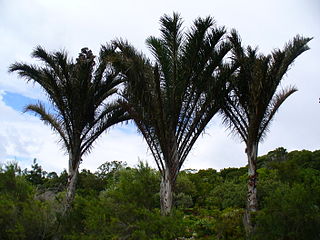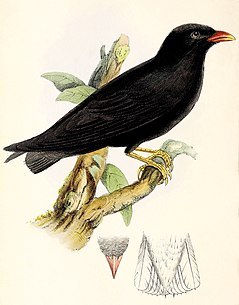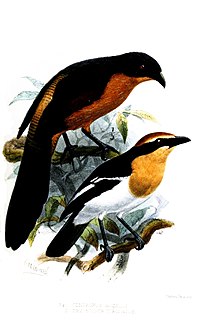
Raffia palms (Raphia) are a genus of about twenty species of palms native to tropical regions of Africa, and especially Madagascar, with one species also occurring in Central and South America. R. taedigera is the source of raffia fibers, which are the veins of the leaves, and this species produces a fruit called "brazilia pods", "uxi nuts" or "uxi pods".

The bay duiker, also known as the black-striped duiker and the black-backed duiker, is a forest-dwelling duiker native to western and southern Africa. It was first described by British zoologist John Edward Gray in 1846. Two subspecies are identified. The bay duiker is reddish brown and has a moderate size. Both sexes reach 44–49 centimetres (17–19 in) at the shoulder. The sexes do not vary considerably in their weights either; the typical weight range for this duiker is 18–23 kilograms (40–51 lb). Both sexes possess a pair of spiky horns, measuring 5–8 centimetres (2.0–3.1 in). A notable feature of this duiker is the well-pronounced solid stripe of black extending from the back of the head to the tail.

Citheronia regalis, the regal moth or royal walnut moth, is a North American moth in the family Saturniidae. The caterpillars are called hickory horned devils. The adult (imago) has a wingspan of 3.75-6.1 in (9.5-15.5 cm). The species was first described by Johan Christian Fabricius in 1793.

The black-collared lovebird also known as Swindern's lovebird is a small, 13.5 cm (5 in) long, African parrot in the genus Agapornis. It is a mostly green parrot with black band on the back of its neck, and a dark greyish-black bill. Both sexes are similar. It is rarely kept in captivity because of its dietary requirement for a native fig.

The African river martin is a passerine bird, one of two members of the river martin subfamily of the swallow family, Hirundinidae. When discovered, it was not initially recognised as a swallow, and its structural differences from most of its relatives, including its stout bill and robust legs and feet, have led to its current placement in a separate subfamily shared only with the Asian white-eyed river martin. The African river martin is a large swallow, mainly black with a blue-green gloss to the head and a greener tint to the back and wings. The under-wings are brownish, the underparts are purple-black, and the flight feathers are black. This martin has red eyes, a broad orange-red bill and a black, square tail. Young birds are similar in appearance to the adults, but have browner plumage. This species has a variety of unmusical calls, and displays both in flight and on the ground, although the purpose of the terrestrial display is unknown.
Raphia regalis is a species of flowering plant in the Arecaceae family. It is found in Angola, Cameroon, Republic of the Congo, Gabon, and Nigeria. Its natural habitat is subtropical or tropical moist lowland forests. It is threatened by habitat loss.

The Gabon coucal is a species of cuckoo in the Cuculidae family. It is mainly found in Gabon but also occurs in neighboring areas of Cameroon, Angola, the Central African Republic, the western Congo Basin and Equatorial Guinea.

The black-headed bee-eater is a species of bird in the family Meropidae. It is found in forests in tropical Central and West Africa, its range including Angola, Central African Republic, Republic of the Congo, Democratic Republic of the Congo, Ivory Coast, Gabon, Ghana, Nigeria, and South Sudan.

The green-breasted pitta is a species of bird in the Pittidae family. It is one of only two Pitta species in Africa, and is found in deep forest of the tropics.

The green-backed woodpecker or little spotted woodpecker, is a species of bird in the family Picidae. It is native to large parts of tropical central Africa. It has an extremely wide range and is an uncommon species, and the International Union for Conservation of Nature has rated its conservation status as being of "least concern".
The African piculet, sometimes placed in the monotypic genus Verreauxia, is a species of bird in the family Picidae. It is found in Angola, Cameroon, Central African Republic, Republic of the Congo, Democratic Republic of the Congo, Ivory Coast, Equatorial Guinea, Gabon, Ghana, Liberia, and Uganda. This species is described as locally common and has a very large range, so the International Union for Conservation of Nature has rated its conservation status as being of "least concern".

The Bates's shrew is a species of mammal in the family Soricidae. It is found in Cameroon, Republic of the Congo, Equatorial Guinea, and Gabon. Its natural habitat is subtropical or tropical moist lowland forests. This large black shrew was first described by the British zoologist Guy Dollman in 1915, the type locality being the vicinity of the Como River in Gabon. The exact definition of this species is unclear; it is often included in Fraser's musk shrew, or reported as Wimmer's shrew. Its karyotype is 2n=50, FN-76, which is identical to the Nigerian shrew, and the species complex is in need of a thorough revision.
Papilio chrapkowskoides, the broadly green-banded swallowtail, is a species of swallowtail butterfly from the genus Papilio that is found in the Republic of the Congo, Uganda, Rwanda, Burundi, Tanzania, Guinea, Sierra Leone, Liberia, Ivory Coast, Ghana, Togo, Benin, Nigeria, Cameroon, Gabon, the Democratic Republic of the Congo, and Angola.

Sternotomis pulchra is a species of beetle belonging to the family Cerambycidae.

Acraea egina, the elegant acraea, is a species of butterfly in the family Nymphalidae.

Zographus oculator, the Orange-eyed Long-horn Beetle, is a species of flat-faced longhorn beetles belonging to the family Cerambycidae.
Zographus cingulatus is a species of beetle in the family Cerambycidae. It was described by Per Olof Christopher Aurivillius in 1913. It is known from the Democratic Republic of the Congo, Angola, and Malawi.
Zographus nitidus is a species of beetle in the family Cerambycidae. It was described by Per Olof Christopher Aurivillius in 1914, originally Quimalanca. It is known from Uganda and the Democratic Republic of the Congo.
Zographus niveipectus is a species of beetle in the family Cerambycidae. It was described by Quedenfeldt in 1888, originally under the genus Sternotomis. It is known from the Central African Republic, Zambia, and the Democratic Republic of the Congo.
Zographus pulverulentus is a species of beetle in the family Cerambycidae. It was described by Nonfried in 1906, originally as a varietas of Zographus aulicus. It is known from the Democratic Republic of the Congo and South Africa.



















